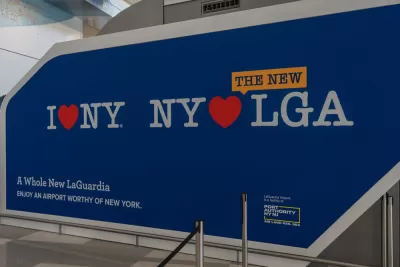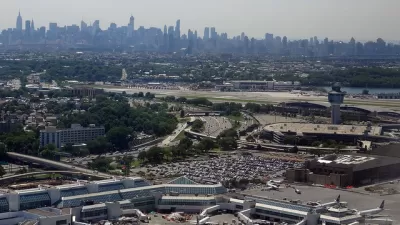After an $8 billion renovation, critics of the much-maligned airport claim the design is disjointed, while public transit access to the new terminals remains minimal.

In a piece for Bloomberg CityLab, James S. Russell describes the $8 billion renovation of “America’s most reviled airport,” New York’s LaGuardia.
Despite the massive investment in the modernization of the new terminals, the airport is, as Russell writes, “trapped in the husk of its reviled predecessor.” This is because “the ‘new’ LaGuardia’s expansion was constrained on a site that opened to pontooned flying boats and DC-3s in 1939. From the air, it looks like taffy pulled in several directions. Recently constructed buildings and roads had to dodge and weave among the detritus of boneheaded decisions past, including bits of the older terminals that had to remain in service as new ones were constructed.”
According to Russell, “Coherence and passenger-calming clarity in wayfinding have always been held sacrosanct by airport designers. But the new Terminal B — while a vast improvement that has been greeted with praise and was awarded the 2021 Prix Versailles, UNESCO’s annual architecture prize — is among the most idiosyncratic that air travelers are likely to encounter.” However, “Despite its busyness, the Terminal B pleases with its detailed focus on its users, from the new, roomier bathrooms to the unintimidating security checkpoint.” Russell goes on to describe Terminal C, designed by and for Delta to maximize efficiency and ease of experience for travelers.
The refreshed airport comes with another caveat: “Access to the airport is likely to continue to induce havoc, since there’s a lingering lack of roadway and parking capacity.” The airport continues to lack good access to public transit, and “ride-hailing services are accommodated as an afterthought.”
FULL STORY: The New LaGuardia Is Haunted by the Mistakes of its Past

Study: Maui’s Plan to Convert Vacation Rentals to Long-Term Housing Could Cause Nearly $1 Billion Economic Loss
The plan would reduce visitor accommodation by 25,% resulting in 1,900 jobs lost.

North Texas Transit Leaders Tout Benefits of TOD for Growing Region
At a summit focused on transit-oriented development, policymakers discussed how North Texas’ expanded light rail system can serve as a tool for economic growth.

Using Old Oil and Gas Wells for Green Energy Storage
Penn State researchers have found that repurposing abandoned oil and gas wells for geothermal-assisted compressed-air energy storage can boost efficiency, reduce environmental risks, and support clean energy and job transitions.

Santa Barbara Could Build Housing on County Land
County supervisors moved forward a proposal to build workforce housing on two county-owned parcels.

San Mateo Formally Opposes Freeway Project
The city council will send a letter to Caltrans urging the agency to reconsider a plan to expand the 101 through the city of San Mateo.

A Bronx Community Fights to Have its Voice Heard
After organizing and giving input for decades, the community around the Kingsbridge Armory might actually see it redeveloped — and they want to continue to have a say in how it goes.
Urban Design for Planners 1: Software Tools
This six-course series explores essential urban design concepts using open source software and equips planners with the tools they need to participate fully in the urban design process.
Planning for Universal Design
Learn the tools for implementing Universal Design in planning regulations.
Ascent Environmental
Borough of Carlisle
Institute for Housing and Urban Development Studies (IHS)
City of Grandview
Harvard GSD Executive Education
Toledo-Lucas County Plan Commissions
Salt Lake City
NYU Wagner Graduate School of Public Service



























